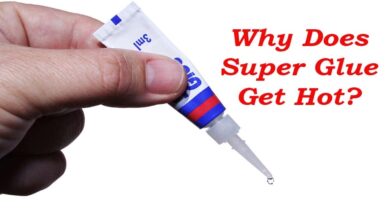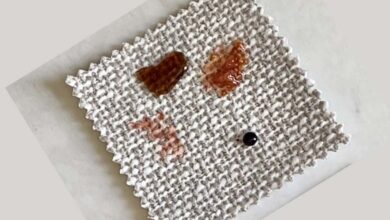How to Glue Fabric to Plastic? A Step-by-Step Guide

Gluing fabric to plastic may seem like a daunting task, but with the right technique and adhesive, it can be easily accomplished. Whether you are working on a craft project, repairing torn upholstery, or creating unique home decor items, knowing how to glue fabric to plastic is a valuable skill.
To glue fabric to plastic, use a fabric adhesive designed to bond fabric to plastic surfaces. However, achieving a strong and long-lasting bond between these two materials requires proper techniques and the right adhesive.
In this article, we will guide you through the process of gluing fabric to plastic step by step, providing valuable tips and recommendations along the way. By following our instructions, you’ll be able to successfully adhere fabric to plastic surfaces with confidence and achieve professional-looking results.
What You Need Before Gluing Fabric To Plastic
Gluing fabric to plastic can be a tricky task, but with suitable materials and techniques, it can be achieved successfully. Before diving into the process, gathering all the necessary tools and supplies is essential to ensure a smooth and hassle-free experience.
I will discuss the essential items you need before gluing fabric to plastic.
Tools And Supplies
To get started, here is a list of essential tools and supplies that you will need:
- Fabric glue: Look for a high-quality glue formulated explicitly for bonding fabric to plastic. Make sure it suits the type of fabric you are working with and can provide a solid and durable bond.
- Plastic surface cleaner: Before gluing, it’s crucial to clean the plastic surface thoroughly to remove any dirt, dust, or grease that could interfere with the adhesive. Use a mild plastic surface cleaner or wipe it with rubbing alcohol.
- Sandpaper or emery cloth: If the plastic surface is smooth or glossy, you may need to roughen it up to improve the glue’s grip. Gently sand the plastic using fine-grit sandpaper or emery cloth, creating a slightly rough texture.
- Fabric scissors: Use a pair of fabric scissors to cut the fabric to the desired shape and size neatly. Make sure they are sharp to ensure clean and precise cuts.
- Clamps or clips: These will come in handy to hold the fabric securely in place while the glue dries. Depending on the size of your project, you can use clamps or clips to provide even pressure and prevent the fabric from shifting.
- Mixing tools: If you are using a two-part epoxy or adhesive, you will need mixing tools such as a disposable container and a stirring stick. Follow the manufacturer’s instructions for proper mixing ratios and techniques.
Having these tools and supplies ready before you start the gluing process will make your task much easier and more efficient. You’ll be well-prepared to tackle any fabric-to-plastic bonding project with confidence. So, gather your materials, and let’s get started on the next steps of gluing fabric to plastic.
How To Glue Fabric To Plastic?

Gluing fabric to plastic can be a tricky task, but with the proper techniques and materials, you can achieve a secure bond that will last. Whether you’re looking to personalize your plastic containers with fabric accents or create a unique craft project, here’s a guide on effectively gluing fabric to plastic.
Preparation Is Key:
Before you start gluing fabric to plastic, you must ensure that both surfaces are clean and free from dirt, oil, or other contaminants. This will ensure better adhesion and a more secure bond.
Clean the plastic surface thoroughly using soap and water. Rinse it well and allow it to dry completely. If the plastic has a glossy or smooth finish, lightly sand the surface to create a rough texture. This will help the glue adhere better.
Choose The Right Adhesive:
Selecting the right adhesive is crucial to ensure a strong bond between the fabric and plastic. Consider using one of the following options for optimal results:
- E6000 craft adhesive: This industrial-strength adhesive is perfect for bonding fabric to plastic. It’s flexible, waterproof, and offers a strong bond. (You can also read my other details article about E6000. To read, click here)
- Fabric glue: Look for fabric glues designed explicitly for bonding fabric to plastic. These glues have the necessary properties to create a durable bond.
- Super glue: Super glue can also be used for lightweight fabrics or small projects. However, it may not be suitable for heavy fabrics or applications that require flexibility.
Apply The Adhesive:
Now that you have the right adhesive and prepared surfaces, follow these steps to glue fabric to plastic successfully:
- Apply a thin and even adhesive layer to the plastic surface using a brush or applicator. Make sure to cover the entire area where the fabric will be attached.
- Press the fabric firmly onto the adhesive-coated plastic surface. Smooth out any wrinkles or bubbles to ensure a flat and even attachment.
- Allow the glue to dry completely according to the manufacturer’s instructions. Depending on the adhesive used, this may take a few hours or overnight.
- For added durability, consider applying a second adhesive layer over the fabric. This will provide extra strength and protection.
With these steps and tips, you can confidently glue fabric to plastic and achieve a secure bond that will withstand daily use. Let your creativity soar as you transform ordinary plastic items into unique, personalized creations with fabric accents.
Additional Safety Tips For Gluing Fabric To Plastic
When gluing fabric to plastic, it is important to prioritize safety to ensure successful and secure adhesion. Here are some additional safety tips to keep in mind throughout the process:
Work in a well-ventilated area:
Adhesive fumes can be harmful if inhaled for prolonged periods. Ensure you are working in a well-ventilated area to avoid potential health risks.
Wear protective gear:
Protect your hands by wearing disposable gloves while working with adhesive. This will keep your hands clean and provide a barrier between the adhesive and your skin.
Read and follow the manufacturer’s instructions:
Every adhesive product comes with its own set of instructions. Reading and following them carefully is crucial to ensure the best results. Pay attention to any specific safety precautions or recommendations provided by the manufacturer.
Prep the surface:
Before applying the adhesive, it is vital to prepare the plastic surface properly. Clean the plastic thoroughly to remove any dirt, dust, or oils hindering adhesion. You can use rubbing alcohol or a mild soap solution to clean the surface.
Perform a test:
A small test patch is advisable before gluing the entire fabric to the plastic. Apply a small amount of adhesive to a scrap piece of fabric and plastic to check the adhesive’s compatibility and the desired bond strength.
Apply the adhesive sparingly:
Remember that less is more when it comes to applying adhesive. Apply a thin and even adhesive layer to the fabric and plastic surfaces. Avoid applying too much adhesive, which can cause a messy and uneven bond.
Allow proper curing time:
After gluing the fabric to the plastic, give it enough time to cure. Follow the manufacturer’s instructions for the recommended curing time. Avoid putting strain on the bond or exposing it to excessive moisture until the adhesive has fully cured.
Avoid stretching or pulling:
Be cautious while handling the fabric and plastic to avoid any unnecessary stretching or pulling. These actions can weaken the bond and compromise the overall strength of the adhesive.
Store adhesive properly:
Proper storage of the adhesive is crucial for its longevity and effectiveness. Seal the adhesive container tightly after use and store it in a cool, dry place away from direct sunlight.
Dispose of adhesive and packaging responsibly:
Once you have completed your project, dispose of any leftover adhesive and packaging responsibly. Follow local regulations for proper disposal or recycling of these materials.
By following these additional safety tips, you can ensure a successful and secure bond when gluing fabric to plastic. Remember to prioritize safety throughout the process to achieve the best results.
Troubleshooting Common Issues With Fabric-To-Plastic Adhesion

Sometimes when attempting to glue fabric to plastic, you may encounter specific issues that can hinder the adhesion process. Now, we will explore some common problems you might encounter and provide troubleshooting tips to help you overcome them.
Fabric Slipping Or Shifting During Adhesion
One of the challenges you may face is the fabric slipping or shifting out of place while attempting to glue it to the plastic surface. This can lead to an uneven or weak bond. Here are a few tips for tackling this issue:
- Make sure to secure the fabric in place using clips or tape before applying the adhesive.
- Consider using a fabric adhesive with a longer drying time, allowing you more flexibility to position the fabric correctly.
- Work in small sections, applying the adhesive and pressing the fabric firmly onto the plastic before moving on to the next section.
Poor Adhesion Strength
If the fabric is not adhering well to the plastic or the bond seems weak, there could be a few reasons. Here are some troubleshooting suggestions:
- Ensure the fabric and plastic surface are clean and free from dust or debris hindering adhesion. Consider using rubbing alcohol or a mild detergent to clean the surfaces.
- Use a high-quality adhesive designed explicitly for fabric-to-plastic bonding. Some general-purpose adhesives may not provide the necessary strength for this type of application.
- Apply the adhesive evenly and adequately, ensuring every fabric part is coated.
Uneven Or Visible Glue Lines
Achieving a seamless and invisible bond is important when gluing fabric to plastic. However, sometimes glue lines can become visible or appear uneven. Here are some troubleshooting tips to address this problem:
- Use a clear or transparent adhesive to minimize the visibility of the glue lines.
- Apply the adhesive evenly and in thin layers to avoid excess glue buildup.
- Consider using a brush or roller to distribute the adhesive and evenly eliminate any streaks or unevenness.
Wrinkles, Bubbles, Or Ripples
Another issue you may encounter is the formation of wrinkles, bubbles, or ripples on the fabric surface after adhesion. These can be unsightly and affect the overall appearance of your project. Follow these tips to prevent or fix this problem:
- Smooth out the fabric before applying the adhesive, ensuring no wrinkles or bubbles are present.
- If you notice wrinkles or bubbles after the adhesive has dried, use a heat gun or blow dryer on a low setting to soften the adhesive and smooth the fabric.
- Work in small sections, pressing the fabric firmly onto the plastic as you go to avoid the formation of ripples.
By troubleshooting these common issues and following the tips provided, you can enhance the fabric-to-plastic adhesion process and achieve a successful bond. Remember to experiment and test different techniques to find the best for your project.
Frequently Asked Questions For How To Glue Fabric To Plastic
Can You Glue Fabric To Plastic?
Yes, it is possible to glue fabric to plastic. There are specific adhesives designed for this purpose that can create a strong bond between the two materials. However, the success of the bonding process depends on the type of fabric and plastic involved, as well as the specific adhesive used.
Can Fabric Be Glued To Plastic For A Permanent Bond?
Yes, the fabric can be successfully glued to plastic, creating a permanent bond that will withstand regular use and washing. Specific glue types are designed for this purpose, such as fabric glue or adhesive tapes. Following the manufacturer’s instructions and properly preparing the fabric and plastic surface will ensure a strong and long-lasting bond.
What Is The Best Glue For Attaching Fabric To Plastic?
When gluing fabric to plastic, choosing the right adhesive for the job is important. The best options include fabric glue, epoxy adhesive, or multi-purpose craft glue. These glues are specially formulated to bond fabric to plastic, providing a strong and durable hold.
Always test the glue on a small, inconspicuous area before applying it to the entire project.
Can I Wash Fabric Glued To Plastic?
Yes, fabric glued to plastic can usually be safely washed, depending on the glue used. It’s important to follow the manufacturer’s instructions regarding washing and care. When laundering, use a gentle cycle and avoid extreme temperatures or harsh chemicals that could weaken the bond.
With proper care, fabric glued to plastic should withstand regular washing without any issues.
How Long Does It Take For Fabric Glue To Dry On Plastic?
The drying time for fabric glue on plastic can vary depending on the type of adhesive used. Generally, it takes about 24 to 72 hours for fabric glue to fully cure. However, it is recommended to follow the instructions provided by the manufacturer for the specific glue being used.
Allow the glued fabric and plastic item to dry undisturbed during this curing period for the best results.
Conclusion
Gluing fabric to plastic can be a simple and effective way to repair or create new items. Following the steps outlined in this article on “how to glue fabric to plastic” can ensure a solid and durable bond between the two materials.
Remember to choose the suitable adhesive for your specific project and always test it on a small area before applying it to the entire surface. With some patience and proper technique, you can successfully glue fabric to plastic and enjoy its many possibilities.
So why wait? Start exploring your creativity today and bring your fabric and plastic projects to life.



